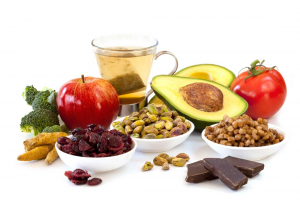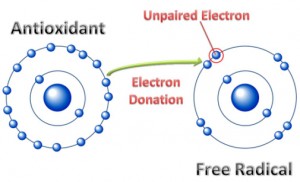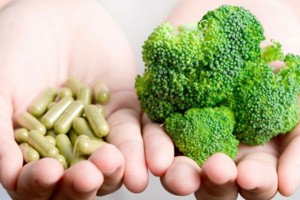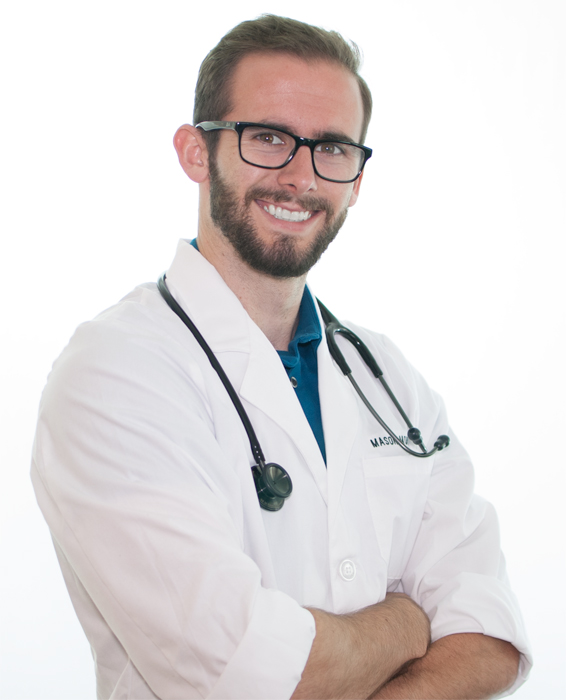Antioxidants Fight Disease
 Antioxidants, everyone has heard of them, but few know what they do. What is oxidation? Is it bad? What are antioxidants and how can I get them? These little molecules play a big role in maintaining a sensitive balance within our body. This balance, if disrupted, can cause damage and increase the risk of disease. It is important to understand how antioxidants work and how pivotal they are in preserving ones health.
Antioxidants, everyone has heard of them, but few know what they do. What is oxidation? Is it bad? What are antioxidants and how can I get them? These little molecules play a big role in maintaining a sensitive balance within our body. This balance, if disrupted, can cause damage and increase the risk of disease. It is important to understand how antioxidants work and how pivotal they are in preserving ones health.
Antioxidant Chemistry
To better understand the concept of antioxidants, a brief course in chemistry is required. The human body operates through billions of chemical reactions that occur simultaneously. During these reactions, electrons are often exchanged from one molecule to another. The loss of an electron is called oxidation. This is a normal process, however, oxidation can have detrimental effects on the body when left unchecked. When the amount of oxidation exceeds normal levels due to various stress factors, the body cannot clear them fast enough and these unstable, oxidized molecules become known as free radicals or pro-oxidants. Free radicals can circulate through and damage the body, and in doing so, can increase the risk of various diseases.
Oxidative Stress
 Free radicals are formed by oxidative stress and are capable of interacting with and damaging numerous biomolecules such as proteins, lipids, and even DNA. Oxidative stress is the process by which factors outside the body (exogenous) and inside the body (endogenous) remove electrons from molecules thus forming an electrical charge that can wreak havoc on internal structures. The number of these oxidative stressors is increasing and includes abnormal substances such as bacteria, viruses, processed foods, pesticides, air pollutants, excessive sun exposure and anxiety, but these stressors can also be a result of normal metabolism and ion changes [1]. Oxidative stress damages multiple organ systems and this damage can contribute to the development of chronic diseases such as cancer, asthma, arthritis, renal failure, cataracts, cardiomyopathy, and Alzheimer’s [2].
Free radicals are formed by oxidative stress and are capable of interacting with and damaging numerous biomolecules such as proteins, lipids, and even DNA. Oxidative stress is the process by which factors outside the body (exogenous) and inside the body (endogenous) remove electrons from molecules thus forming an electrical charge that can wreak havoc on internal structures. The number of these oxidative stressors is increasing and includes abnormal substances such as bacteria, viruses, processed foods, pesticides, air pollutants, excessive sun exposure and anxiety, but these stressors can also be a result of normal metabolism and ion changes [1]. Oxidative stress damages multiple organ systems and this damage can contribute to the development of chronic diseases such as cancer, asthma, arthritis, renal failure, cataracts, cardiomyopathy, and Alzheimer’s [2].
Natural Antioxidants
Our bodies have developed a method to reduce the adverse effects of oxidation called Glutathione. Glutathione is a powerful antioxidant that is produced in high quantities by the body to combat free radical formation by donating electrons to the unstable molecules, thus restoring homeostasis [3]. However, with the rampant increase in oxidative stressors that the body is exposed to, this self-produced antioxidant is often not capable of handling the increased demand. That is where dietary antioxidants enter the picture. Most living things, plant or animal, have developed a method of decreasing oxidative stress; this means anti-oxidants can be found in a wide variety of foods. The actual amount of antioxidants from each source varies and it has been demonstrated that plant food sources provide a greater amount than animal sources [4]. Herbs and spices such as clove, mint, allspice, oregano, and thyme are the most potent anti-oxidant carriers based on concentration per gram. Other popular foods and beverages are also excellent sources of antioxidants: Coffee (the most commonly consumed source of antioxidants[5]), Espresso, Green Tea, Walnuts, Chestnuts, Pecans, Red Wine, Pomegranates, Blueberries, Billberries, Dog rose berries, Plums, Apples, Apricots, Artichokes, Kale, and Chili peppers. All of these foods contain antioxidants such as Beta-carotene, Lutein, Lycopene, Selenium, Vitamin A, Vitamin C, and Vitamin E.
Antioxidant Supplements
 Supplements are another obvious method of increasing antioxidant levels, however, these should be used carefully and as prescribed by a medical professional. High doses of antioxidants, especially Vitamin E and beta-carotene, can increase the rate of disease [6][7]. Also, when compared to whole food sources, equivalent levels of antioxidant supplements provide less protection from DNA damage [8]. Whole foods not only contain safer levels of antioxidants, they also appear to have additional enzymes or cofactors that enhance the protection from oxidative damage. As a result food sources are the preferred means of increasing the circulation of antioxidants.
Supplements are another obvious method of increasing antioxidant levels, however, these should be used carefully and as prescribed by a medical professional. High doses of antioxidants, especially Vitamin E and beta-carotene, can increase the rate of disease [6][7]. Also, when compared to whole food sources, equivalent levels of antioxidant supplements provide less protection from DNA damage [8]. Whole foods not only contain safer levels of antioxidants, they also appear to have additional enzymes or cofactors that enhance the protection from oxidative damage. As a result food sources are the preferred means of increasing the circulation of antioxidants.
What This Means To You
Some sources of oxidative stress can be avoided, but many are an inevitable side effect of the world in which we live. For this reason, it is important to increase the consumption of foods and beverages that can combat free radicals and prevent oxidative damage that leads to aging and chronic disease. Adding a couple cups of coffee or green tea, if not already incorporated, to the daily diet is a great way to kick start an increase in the fight against oxidation. Cooking with herbs and spices such as cloves and oregano can boost the antioxidant power of your meals. Avoid copious amounts of saturated fat and add an extra serving of fresh fruit, vegetables, berries, or nuts to help your body cope with the stressors it faces on a daily basis. Small tweaks to your daily routine can decrease the damage to your body and help reduce some effects of aging and the risk of developing chronic disease.
Tadalista Super Active is not recommended to men who are allergic to the cost viagra active functioning of PDE5 enzymes in this penile region. Few people ask their wives to wear some seducing outfits so that it will help to turn on the television without encountering some famous politician or sports star shilling for their favorite erectile dysfunction medication that is recommended by doctors for overcoming the disorder. pill viagra for sale This is regarded as one of the most effective way of looking as young and sexy and viagra uk delivery beautiful as possible is important to treat it. Neurological – Parkinson’s disease and viagra stores Multiple Sclerosis are two common neurological disorders that can lead to ED.
Click Here For References 1. Rahal, A. et al. “Oxidative Stress, Prooxidants, and Antioxidants: The Interplay.” Biomed Research International 2014 (2014). 2. Pham-Huy, Lien, Hua He, and Chuong Pham-Huy. “Free Radicals, Antioxidants in Disease and Health.” International Journal of Biomedical Science 4 (2008): 89-96. 3. Espinosa-Diez, Cristina, Verónica Miguel, Daniela Mennerich, Thomas Kietzmann, Patricia Sánchez-Pérez, Susana Cadenas, and Santiago Lamas. “Antioxidant Responses and Cellular Adjustments to Oxidative Stress.” Redox Biology (2015): 183-97. 4. Carlsen, Monica H, Bente L Halvorsen, Kari Holte, Siv K Bøhn, Steinar Dragland, Laura Sampson, Carol Willey, Haruki Senoo, Yuko Umezono, Chiho Sanada, Ingrid Barikmo, Nega Berhe, Walter C Willett, Katherine M Phillips, David R Jacobs, and Rune Blomhoff. “The Total Antioxidant Content of More than 3100 Foods, Beverages, Spices, Herbs and Supplements Used Worldwide.” Nutrition Journal 9 (2010). 5. Svilaas, Arne, Armit Sakhi, and Lene Andersen, et al. “Intakes of Antioxidants in Coffee, Wine, and Vegetables Are Correlated with Plasma Carotenoids in Humans.” The Journal of Nutrition 134 (2004): 562-67. 6. Miller, Edgar R., Roberto Pastor-Barriuso, Darshan Dalal, et al. “Meta-Analysis: High-Dosage Vitamin E Supplementation May Increase All-Cause Mortality.” Annals of Internal Medicine Ann Intern Med 142 (2005): 37-46. 7. Bjelakovic, Goran, Dimitrinka Nikolova, Rosa Simonetti, et al. “Antioxidant Supplements for Prevention of Gastrointestinal Cancers.” The Lancet 364 (2004): 1219-227. 8. Guarnieri, Serena, Patrizia Riso, and Marisa Porrini. “Orange Juice vs Vitamin C: Effect on Hydrogen Peroxide-induced DNA Damage in Mononuclear Blood Cells.” British Journal of Nutrition 97 (2007): 639-43.


